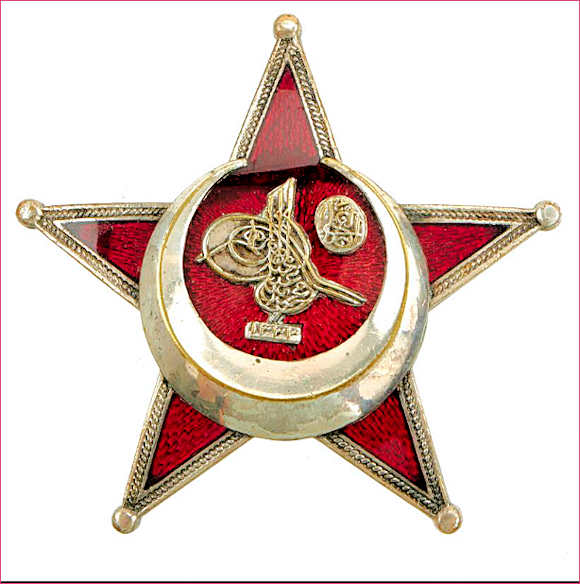[Editor's Note: On 9 June 2022, we presented regular contributor Jim Patton's article on Australia's "Gallipoli Star" military decoration. Here another of our contributors, Col. Bill Anderson, USMC, presents a parallel article on Turkey's Gallipoli Star.
Col. William Anderson, USMC
Prior to 1914, the Ottoman Empire did not have a general war medal for military merit. There had been campaign decorations with specific clasps to denote a particular campaign. Inspired by the German awards of the Iron Cross Medal and the Austrian Military Merit Medal, the commanders of the Ottoman Army felt it was appropriate for such an award for Turkish soldiers. In March 1915, the “War Medal” (Harp Madalyası) was authorized. It was not a campaign decoration but one for military merit or gallantry with only one class. It was to be worn on the right breast below the heart of the military tunic. It was authorized for anyone regardless of rank or title/position, to include allies.
 |
| Original Oval Design |
The first design was for an oval bronze badge but, it appears, such a decoration was never issued prior to August when a new design was authorized. The new version would be the classic 5-pointed red star shown at the top.
The Obverse contains an upturned crescent circling the red center of the badge. Within the center is the tughra or seal of Sultan Mehmed Reshad V over the date “1333” (1915). The Reverse is flat, unadorned and has a straight pin.
Click on Image to Enlarge
The War Medal was issued in two versions – for officers made of silvered brass and for other ranks of thin lacquered white metal. However, any recipient could purchase finer versions from numerous German jewelers who made them during WWI and afterwards. German soldiers did just that and the finer jeweler versions are prized collector items, especially if associated with a well-known name. In homage, I guess, to the Iron Cross awards, the Entente soldiers referred to the Turkish award as the Eiserne Halbmond or Iron Crescent. Informally, it is still identified as the “Gallipoli Star” which causes some confusion with British and Commonwealth decorations of the war.
Sources: M. Demir Erman, "The Turkish War Medal," privately published, undated; Edhem Eldem, "The Changing Design and Rhetoric of Ottoman Decorations, 1850-1920," Journal of Decorative and Propaganda Arts, 2016; star image, author's collection; oval, Eldem article.



Well done, Bill. Not common knowledge for sure
ReplyDelete